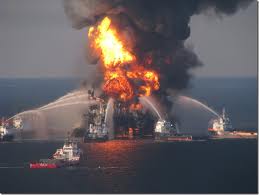Posted in accidents, well control incidents, tagged accidents, Australia, blowouts, BOE, Deepwater Horizon, drilling, Gulf of Mexico, macondo, Montara, offshore oil, oil spill, relief well, safety, well control, well integrity test on July 27, 2010|
1 Comment »
In the Gulf of Mexico, deepwater drilling is more risky because that is where the high-rate wells are, not because the water is deep.
- Water depth had little to do with the well integrity problems at Macondo. Similar errors in planning and execution would have yielded similar results in any water depth or on land. Has Montara already been forgotten?
- Subsea BOP stacks have a much better performance record than the surface stacks used in shallow water drilling (more on this later in the week).
- Historical data indicate that blowouts occur less frequently in deep water, not more frequently (more to follow).
- Obviously, blowouts involving high-rate wells are likely to do more damage. This applies regardless of the water depth. You can reduce the spill risk by prohibiting drilling in the areas with the highest production potential, but that wouldn’t be very sound energy policy and you won’t find many buyers for the leases.
- It is safer to conduct intervention and capping operations on subsea wells. Regulators would not even allow surface capping to be considered at Montara because of the high risk to workers. The subsurface ROV work is perhaps the biggest Macondo success story.
- If the Macondo well was in shallow water (with the wellhead above the water surface), and well integrity concerns precluded a risky surface capping operation, how would the flow have been contained and collected?
- Other things being equal, the environmental risk is less at deepwater locations which tend to be farther from shore.
Water depth is just one well planning consideration. Abnormal pressures and temperatures, shallow gas, hydrogen sulfide, ice, permafrost, storms, currents, extended reach targets, and horizontal completions are some of the others. To prevent another Macondo, in the US or anywhere else in the world, we need to focus our attention on the 3 categories of issues listed below. These issues are important in all water depths and in all environments.
- Well integrity including design, construction, barriers, verification, and monitoring.
- BOPE performance and reliability under all conditions.
- Capping, containing, and collecting oil in the event of a blowout.
Read Full Post »






